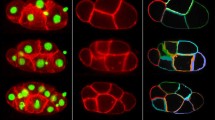Summary
Embryos of the free-living soil nematodeCaenorhadditis elegans are capable of developing normally outside the mother; we have monitored this process in isolated embryos by light microscopy and recorded it on video tape. The size and position of each nucleus were entered into a computer at short time intervals from the 2- to 102-cell stages. Models were reconstructed in which nuclei are represented by spheres and assigned different colors and patterns according to lineage membership. Three-dimensional reconstructions aid visualization of the spatial arrangement of nuclei and demonstrate the small degree of positional variance among individuals. The dynamic processes of nuclear growth during the cell cycle, division, migration, and patern formation can be quantitatively analyzed. Our knowledge of the complete embryonic lineage allows the correlation of nuclear behavior with eventual cellular fate.
Similar content being viewed by others
References
Boveri T (1910) Die Potenzen der Ascaris-Blastomeren bei abgeänderter Furchung. Festschrift R. Hertwig, vol 3. Fischer, Jena, pp 133–214
Chitwood BG, Chitwood MB (1950) Introduction to Nematology. University Park Press, Baltimore
Dam WI van, Dohmen MR, Verdonk NH (1982) Localization of morphogenetic determinants in a special cytoplasm present in the polar lobe ofBithynia tentaculata (Gastropoda). Wilhelm Roux's Arch 191:371–377
Denich K, Schierenberg E, Isnenghi E, Cassada R (1984) Celllineage and developmental defects of temperature-sensitive embryonic arrest mutants of the nematodeCaenorhabditis elegans. Wilhelm Roux's Arch 193:164–179
Deppe U, Schierenberg E, Cole T, Krieg C, Schmitt D, Yoder B, Ehrenstein G von (1978) Cell lineages of the embryo of the nematodeCaenorhabditis elegans. Proc Natl Acad Sci USA 75:376–380
Ehrenstein G von, Schierenberg E (1980) Cell lineages and development ofCaenorhabditis elegans and other nematodes. In: Zuckerman B (ed) Nematodes as biological models, vol 1. Academic Press, New York, pp 1–71
Kimble J, Hirsh D (1979) The postembryonic cell lineages of the hermaphrodite and male gonads inCaenorhabditis elegans. Dev Biol 70:396–417
Krieg C, Cole T, Deppe U, Schierenberg E, Schmitt D, Yoder B, Ehrenstein G von (1978) The cellular anatomy of embryos of the nematodeCaenorhabditis elegans. Dev Biol 65:193–215
Laufer JS, Bazzicalupo P, Wood WB (1980) Segregation of developmental potential in early embryos ofCaenorhabditis elegans. Cell 19:569–577
Laufer JS, Ehrenstein G von (1981) Nematode development after removal of egg cytoplasm: Absence of localized unbound determinants. Science 211:402–405
Newport J, Kirschner M (1982) A major developmental transition in earlyXenopus embryos: I. Characterization and timing of cellular changes at the midblastula stage. Cell 30:675–686
Schierenberg E (1984) Altered cell division rates after laser-induced cell fusion in nematode embryos. Dev Biol101:240–245
Schierenberg E, Wood WB (1984) Control of cell cycle timing in early embryos ofCaenorhabditis elegans. Dev Biol [in press]
Schierenberg E, Miwa J, Ehrenstein G von (1980) Cell lineages and developmental defects of temperature-sensitive embryonic arrest mutants inCaenorhabditis elegans. Dev Biol 76:141–159
Strassen O zur (1951) Der Erbgang der Nematoden-Asymmetrie Verh Dt Zool Ges Wilhelmshaven, pp 77–81
Strassen O zur (1959) Neue Beiträge zur Entwicklungsmechanik der Nematoden. Zoologica 107: 1–142
Sulston JE, Horvitz HR (1977) Post-embryonic cell lineages of the nematodeCaenorhabditis elegans. Dev Biol 56:110–156
Sulston JE, Albertson DG, Thomson JN (1980) TheCaenorhabditis elegans male: Postembryonic development of non-gonadal structures. Dev Biol 78:542–576
Sulston JE, Schierenberg E, White J, Thomson N (1983) The embryonic cell lineages of the nematodeCaenorhabditis elegans. Dev Biol 100:64–119
Whittaker JR (1982) Muscle lineage cytoplasm can change the developmental expression in epidermal lineage cells of accidian embryos. Dev Biol 93:463–470
Wood WB, Hecht R, Carr S, Vanderslice R, Wolf N, Hirsh D (1980) Parental effects and phenotypic characterization of mutants that affect early development inCaenorhabditis elegans. Dev Biol 74:446–469
Author information
Authors and Affiliations
Rights and permissions
About this article
Cite this article
Schierenberg, E., Carlson, C. & Sidio, W. Cellular development of a nematode: 3-D computer reconstruction of living embryos. Wilhelm Roux' Archiv 194, 61–68 (1984). https://doi.org/10.1007/BF00848345
Received:
Accepted:
Issue Date:
DOI: https://doi.org/10.1007/BF00848345




